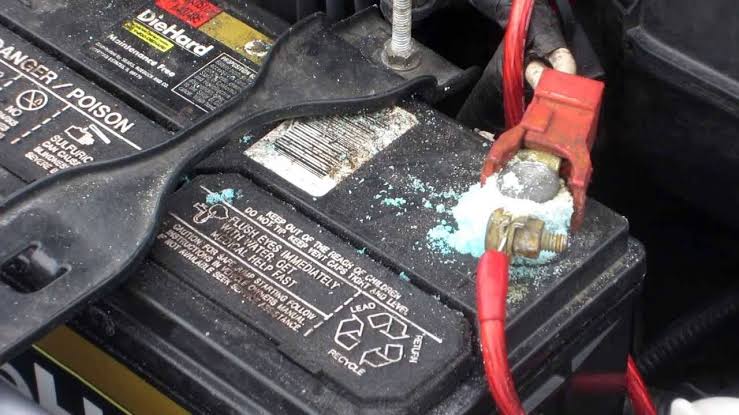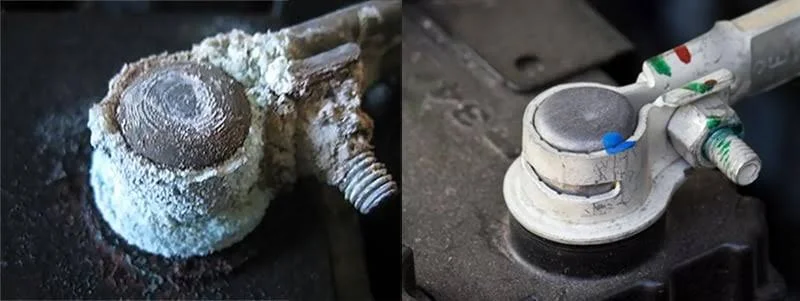AAA reports that 17 million roadside assistance calls in 2014 were battery related, including corroded terminals, many of which could have been prevented with a pantry staple most drivers already own.
Picture this. You're running late for an important meeting when your car refuses to start. The engine cranks weakly, then silence. Your first thought? "The battery is dead." But what if I told you the problem might be something far simpler, and more preventable than you think?
As someone who's been turning wrenches for over two decades, I can tell you that battery terminal corrosion catches more drivers off guard than any other maintenance issue. The irony? It's one of the easiest problems to prevent and fix. Yet according to AAA's comprehensive roadside assistance data, corroded or dirty battery terminals contribute to millions of service calls each year.
Here's what really gets me: the solution costs about 50 cents and takes less than 10 minutes.
The $200 Problem That Baking Soda Solves
Walk into any auto parts store and you'll find battery terminal cleaners ranging from $8 to $15. Professional cleaning at a shop? That'll run you $50 to $100. Meanwhile, that box of baking soda sitting in your kitchen pantry does the exact same job, sometimes better.
The science is straightforward. Battery corrosion forms when sulfuric acid vapor escapes from your battery and reacts with the metal terminals. This creates that crusty, white-green buildup you've probably seen. When baking soda (sodium bicarbonate) meets this acidic corrosion, it neutralizes the acid through a simple chemical reaction. You'll actually see it fizz as it works!
"My battery looked fine to me," customers often tell me when they're surprised by electrical problems. But here's the thing: even a thin layer of corrosion can create enough resistance to prevent proper electrical flow. Your alternator might be perfect, your battery might have plenty of juice, but if the connection is compromised, you're going nowhere.
The Professional's 10 Minute Solution
After countless shop visits dealing with corroded terminals, I've refined this process to its essentials. Here's exactly how to do it right:
What you need:
- 1 tablespoon baking soda
- 1 cup warm water
- Old toothbrush or wire brush
- Safety glasses and gloves
- Clean rags
- Petroleum jelly or terminal protector spray
The process
- Safety first. Turn off your engine and remove the keys. Put on safety glasses, battery acid is nothing to mess with.
- Disconnect carefully. Remove the negative terminal first (it's marked with a minus sign), then the positive. This prevents accidental shorts.
- Mix your solution. One tablespoon of baking soda in a cup of warm water. Stir until completely dissolved.
- Apply and watch the magic. Pour the solution directly onto the corroded areas. You'll see it bubble and fizz, that's the acid being neutralized.
- Scrub gently. Use your brush to work away the loosened corrosion. Don't be aggressive; let the chemical reaction do the heavy lifting.
- Rinse and dry. Use clean water to rinse away all residue, then dry thoroughly with a clean rag.
- Protect for the future. Apply a thin layer of petroleum jelly or terminal protector spray to slow future corrosion.
The entire process takes less time than waiting for roadside assistance. And unlike commercial cleaners, baking soda won't harm your paint if it splashes.
Why This Knowledge Gap Exists
Here's something that might surprise you: AAA's data shows that 65% of drivers have never had their battery tested before it fails to start. Even more telling, many drivers assume electrical problems require expensive professional diagnosis.
"I don't want to mess with the electrical system," is something I hear weekly. I understand the hesitation. Modern cars are complex. But cleaning battery terminals isn't rewiring your house, it's basic maintenance, like checking your oil or tire pressure.
The problem compounds when drivers ignore the early warning signs. Slow engine cranking, dim headlights, or that telltale clicking sound when you turn the key, these often point to connection issues, not battery failure. By the time corrosion becomes visible, it's been affecting your car's performance for months.
Beyond the Quick Fix
While the baking soda trick works brilliantly for cleaning existing corrosion, smart drivers think prevention. Here's what separates the prepared from the stranded:
Monthly visual inspections are your first line of defense. Pop the hood and look for that telltale white or green buildup around the terminals. Catch it early, and a quick cleaning prevents bigger problems.
Proper terminal protection matters more than most realize. After cleaning, a thin coating of petroleum jelly or purpose made terminal protector creates a barrier against acid vapors. This simple step can extend the time between cleanings by months.
Battery age awareness is crucial. AAA recommends annual testing once your battery hits three years old. Older batteries are more prone to leaking the vapors that cause corrosion.
When Baking Soda Isn't Enough
Sometimes you'll encounter corrosion that's beyond the basic cleaning method. Heavy buildup that doesn't respond to the baking soda solution, or terminals that show signs of actual damage, need a different approach.
If the metal terminals themselves are pitted or eaten away, you're looking at replacement rather than cleaning. Similarly, if the battery case shows cracks or obvious acid leakage, the whole battery needs to go. These situations require professional attention, but they're the exception, not the rule.
The key is knowing when you've found the limit of DIY maintenance. Electrical systems can be unforgiving, and there's no shame in calling for backup when the situation demands it.
The Bottom Line for Smart Drivers
In my experience, the drivers who avoid roadside drama are the ones who embrace simple preventive maintenance. They understand that a $0.50 solution applied monthly beats a $200 tow truck call every time.
The baking soda trick isn't revolutionary technology, it's basic chemistry that's been saving drivers money and frustration for decades. What's changed is how disconnected many of us have become from simple car care.
Your vehicle will serve you faithfully if you give it the basic attention it deserves. And sometimes, that attention comes from something as simple as what's already sitting in your kitchen cabinet.
Next time you're checking your oil or washing your car, take 30 seconds to look at those battery terminals. If you see the first signs of that white or green buildup, you now know exactly what to do. Your future self, the one not waiting for a tow truck, will thank you.
- Remember: While this cleaning method is safe and effective for most situations, always prioritize safety when working around car batteries. If you're uncomfortable performing any maintenance task, consult with a qualified automotive professional.


Comments (0)
Please login to join the discussion
Be the first to comment on this article!
Share your thoughts and start the discussion